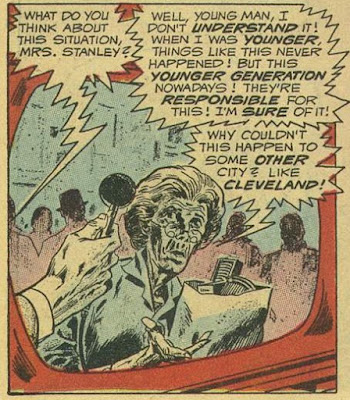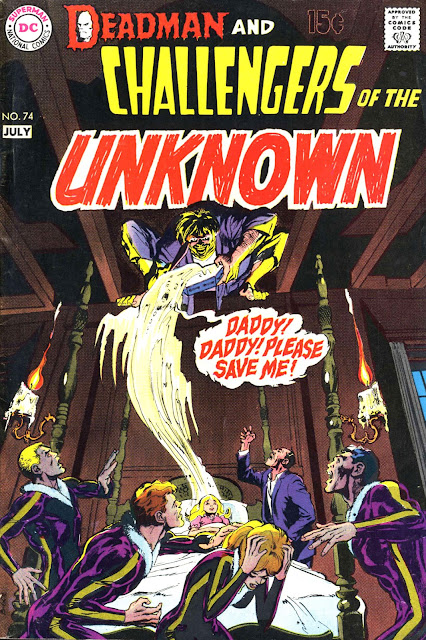AQUAMAN #56 April 1971
Anybody buying AQUAMAN #56 in January 1971 would have been justified in feeling somewhat short-changed by its contents if they were anticipating the monster story suggested by its cover. 'The Creature that Devoured Detroit' is an unusual tale by any definition, the false promise of its cover being just one of several idiosyncrasies, some of which are laudable, others perhaps less so.
So, the first odd thing about this issue, written by Steve Skeates and illustrated by Jim Aparo, is perhaps not so odd at all when placed in context with the practice common at the time of covers which were intentionally misleading or promised far more than would be delivered. The cover clearly depicts a huge, red-eyed, grasping monster emerging from the water, its hands reaching out over the city towards Aquaman who is speeding towards it. And the creature appears again on the issue's title page, this time seemingly undeterred by a right-hook our hero is delivering.
But, (spoiler alert!) the creature seen in these images is in actual fact just a metaphor for encroaching "green gook" caused by an upset to the climatic balance over the city. In fact it turns out to be little more than a McGuffin to get Aquaman involved in the narrative.
Rather than appear in the form of a sentient creature it is at its most animated when it appears as a freak wave which "breaks out of the lake" engulfing a little girl.
The following page, ambitiously subtitled 'Aquaman vs the Creature' shamelessly depicts nothing more engaging than our hero simply pulling the girl out of the inanimate slime and returning her to her mother--
And that's the sum total of the so-called Creature's appearances in the story, believe it or not. A newsman declares that "the growth has become very unpredictable in these last hours" and the citizens are evacuated, but the threat itself seems very low-budget, surprisingly so really, since the great advantage of comics over other media is that the budget is only confined by their creators' imaginations. On the up-side, Skeates does take the opportunity to parody the sort of reactionary talking heads TV newscasts enjoy giving airtime to--
Not that the idea to use television as a way of telling the story is always so effective. Even more egregious than the no-show of a chilling monster is the writer's dependence on verbose sections to layer in lots of details which might have been delivered more effectively in a visual medium. Page 3, for instance, is overloaded with wordage as the writer uses the conceit of a TV talk-show to get across an enormous amount of exposition--
But some of the odder elements of this story are in fact more welcome than such long-winded sections. The story opens somewhat intriguingly, teasing the reader that this is going to be a domestic drama centring on the travails of a couple whose relationship seems to be fraying badly--
To be honest I'd have sooner read three more pages detailing their marital strife than the three pages we're offered of the lame talk-show. Instead the couple (we only seem to be given the woman's name-- Ethel) only seem to have one function in the narrative, which is to respond to the TV somewhat wryly--
Where I feel the issue is most successful is in its introduction of a would-be super-hero-- Crusader-- like Aquaman himself, an orange-suited crimefighter, but one whose special power seems only to be his agility and fighting ability--
I also enjoyed the way Aquaman catches up with an old friend, Don Powers, only to discover he is in fact behind the circumstances that have led to the phenomenon of the unending daylight in Detroit--
Admitting that he has himself installed a satellite to keep the city light 24 hours a day, thereby reducing the city's crime figures, Powers is in addition presented as an unashamed anti-conservationist. He does not care about the effects on the city's ecology as long as his own ends are served. Through him, Aquaman is forced to confront the reality that people change, that a person you knew years ago may not necessarily still hold the values they once did--
Interestingly Powers brands Aquaman "left-wing", Skeates' positioning of the story's antagonist effectively as a right-wing authority-figure, in harmony with the way writers like Denny O'Neil were regularly offering young readers politically challenging concepts during this period--
And then, as seen in the same frame, there's Aquaman's intriguing response to Powers' mention of Crusader-- The Sea King hasn't yet (spoiler alert!) discovered that Powers is in fact Crusader, but he labels him "a two-bit super-hero", revealing how he was rejected by the Justice League for being too violent. As far as I know that's a story that was never told in any comic, which is kind of a shame. To be honest I'd like to know exactly this guy was doing that the others in the JLA weren't--
Another welcome touch is the bravado use of sub-titles throughout the entire issue, giving it a distinct sense of forward motion like a series of short episodes woven together to make a singular narrative--
Later we learn that Crusader is something of a flawed hero anyway, his motivation not being to benefit others so much as to boost his own ego--
Again when depicting the character's demise, Skeates writes as if bound by budgetary constraints as he opts not to depict (spoiler warning again!) Crusader's dramatic fall from a rooftop, choosing instead to write it like a radio or stage play, employing a witness to the incident to explain what happened instead. Another case of telling not showing in a medium which thrives on show-don't-tell--
Of course the story ends with (spoiler! spoiler!) Aquaman saving the day by destroying the satellite with the press of a convenient red-button. It's very abrupt considering the long drawn out sequences of earlier, a case where an extra few panels to include some reaction to the events and their conclusion would have been far more satisfying--
As I said at the start, AQUAMAN #56 is quite an odd issue, promising so much -a monster, a humorous domestic drama, a flawed Super-hero, an environmental disaster, the betrayal of a friend- but delivering them perhaps less effectively than might have been hoped, probably because ultimately it tried to pack too many good ideas into a mere 20 pages. Even more oddly, at the end of the main story, the issue then proceeds to dedicate an additional two pages to a somewhat ho-hum Aquagirl short, THE CAVE OF DEATH, when perhaps those pages could have been used to fill out the main story's ending--
But wait, there are even odder aspects to this issue-- THE CAVE OF DEATH ends with a cryptic suggestion that the ominous sounding underwater location will be a significant factor in forthcoming stories. Fair enough, except that this was to be the final issue of AQUAMAN (at least until the series was revived in the late 70s), so it's something of a false promise.
And wait again, there's more-- Three and a half years after this issue of AQUAMAN there was a sequel, of sorts, to the main story in which it is revealed that the slime might well have been sentient, as suggested by the issue's cover, and that moments before Aquaman pressed the red button, it -or something very like it- had boarded the soon-to-be-destroyed satellite--
The explosion catapults it to Earth and it takes on what can only be described as the form of an underwater Swamp-Thing--
Once again the sea-dwelling Super-hero must defeat this slimy menace-- but which sea-dwelling Super-hero?
That's right, Steve Skeates was by now writing for Marvel's SUB-MARINER, whose final issue in 1974 included the cheeky story FROM THE VOID IT CAME, in which it is Namor, not Aquaman, who takes on 'The Slime Thing'--
Which possibly makes DC's AQUAMAN #56 one of the oddest comics published, if not of all time, then certainly of 1971.
In case you missed them, please check out some of my recent blog entries by clicking the covers below--


































Comments
Post a Comment